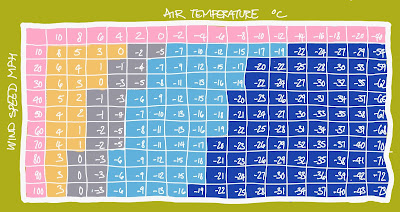The wind chill effect is the temperature that a person feels because of the wind.
 |
| Air temperature feels colder combined with exposure to wind. |
It's a combination of the external temperature and wind speed.
 |
For example, a bottle of water placed outside at 4ºC, exposed to the wind
will cool to the ambient temperature quicker than the same bottle placed in a fridge at 4ºC
(even with the fridge door closed). |
The temperature of water in the bottle will not descend below 4ºC but the temperature will fall as it it were affected by a lower temperature. This is why we are vulnerable to frost bite in low temperatures and high winds. The heat can be stripped from our skin very rapidly.
 |
The wind chill table demonstrates how quickly the energy can be stripped from
a heat-producing object |
Because a building produces heat, it is also affected by the wind chill effect.
 |
| This is because heat is stripped away more quickly from an object subjected to wind. |
They just can't tell us because, unlike people, they generally have no sensors to register the effect and they do not normally shiver. It generally relates to the amount of additional heat a building has to produce to compensate for the wind chill effect.
 |
Buildings in exposed locations (top row above) will feel wind chill more than
buildings in sheltered locations or less exposed surface area (bottom row). |
Fortunately the wind chill effect is subject to conditions which can be influenced by building design. This could save up to 20% of energy used for heating.
 |
Adding an additional skin to the building can create a zone 20 to 200cm where air can be
tempered and controlled to reduce the wind chill effect. |
Buildings with a single skin or narrow ventilation cavity are more affected by wind chill. Adding additional layers, obstacles or landscaping can reduce the the affect.
 |
Landscaping and trees can reduce the the exposure of a building to the wind (left)
Adding a secondary skin to the building can create a controlled environmental space reducing wind chill exposure (right)
|
 |
Building in to the ground, under a green roof or next to water etc. (left)
Or building a mega roof such as Buckminster Fuller's project for Manhattan (right)
|
 |
Using a green roof and green living wall reduces wind chill (left)
Using an external wall to shield the building also helps (right) |
Some of the many ways building design can be articulated to minimise the affects of wind chill.









